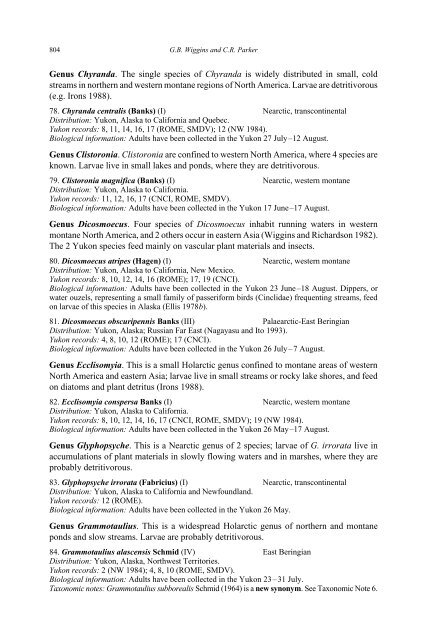Caddisflies of the Yukon - Department of Biological Sciences ...
Caddisflies of the Yukon - Department of Biological Sciences ...
Caddisflies of the Yukon - Department of Biological Sciences ...
You also want an ePaper? Increase the reach of your titles
YUMPU automatically turns print PDFs into web optimized ePapers that Google loves.
804 G.B. Wiggins and C.R. Parker<br />
Genus Chyranda. The single species <strong>of</strong> Chyranda is widely distributed in small, cold<br />
streams in nor<strong>the</strong>rn and western montane regions <strong>of</strong> North America. Larvae are detritivorous<br />
(e.g. Irons 1988).<br />
78. Chyranda centralis (Banks) (I) Nearctic, transcontinental<br />
Distribution: <strong>Yukon</strong>, Alaska to California and Quebec.<br />
<strong>Yukon</strong> records: 8, 11, 14, 16, 17 (ROME, SMDV); 12 (NW 1984).<br />
<strong>Biological</strong> information: Adults have been collected in <strong>the</strong> <strong>Yukon</strong> 27 July –12 August.<br />
Genus Clistoronia. Clistoronia are confined to western North America, where 4 species are<br />
known. Larvae live in small lakes and ponds, where <strong>the</strong>y are detritivorous.<br />
79. Clistoronia magnifica (Banks) (I) Nearctic, western montane<br />
Distribution: <strong>Yukon</strong>, Alaska to California.<br />
<strong>Yukon</strong> records: 11, 12, 16, 17 (CNCI, ROME, SMDV).<br />
<strong>Biological</strong> information: Adults have been collected in <strong>the</strong> <strong>Yukon</strong> 17 June –17 August.<br />
Genus Dicosmoecus. Four species <strong>of</strong> Dicosmoecus inhabit running waters in western<br />
montane North America, and 2 o<strong>the</strong>rs occur in eastern Asia (Wiggins and Richardson 1982).<br />
The 2 <strong>Yukon</strong> species feed mainly on vascular plant materials and insects.<br />
80. Dicosmoecus atripes (Hagen) (I) Nearctic, western montane<br />
Distribution: <strong>Yukon</strong>, Alaska to California, New Mexico.<br />
<strong>Yukon</strong> records: 8, 10, 12, 14, 16 (ROME); 17, 19 (CNCI).<br />
<strong>Biological</strong> information: Adults have been collected in <strong>the</strong> <strong>Yukon</strong> 23 June –18 August. Dippers, or<br />
water ouzels, representing a small family <strong>of</strong> passeriform birds (Cinclidae) frequenting streams, feed<br />
on larvae <strong>of</strong> this species in Alaska (Ellis 1978b).<br />
81. Dicosmoecus obscuripennis Banks (III) Palaearctic-East Beringian<br />
Distribution: <strong>Yukon</strong>, Alaska; Russian Far East (Nagayasu and Ito 1993).<br />
<strong>Yukon</strong> records: 4, 8, 10, 12 (ROME); 17 (CNCI).<br />
<strong>Biological</strong> information: Adults have been collected in <strong>the</strong> <strong>Yukon</strong> 26 July – 7 August.<br />
Genus Ecclisomyia. This is a small Holarctic genus confined to montane areas <strong>of</strong> western<br />
North America and eastern Asia; larvae live in small streams or rocky lake shores, and feed<br />
on diatoms and plant detritus (Irons 1988).<br />
82. Ecclisomyia conspersa Banks (I) Nearctic, western montane<br />
Distribution: <strong>Yukon</strong>, Alaska to California.<br />
<strong>Yukon</strong> records: 8, 10, 12, 14, 16, 17 (CNCI, ROME, SMDV); 19 (NW 1984).<br />
<strong>Biological</strong> information: Adults have been collected in <strong>the</strong> <strong>Yukon</strong> 26 May –17 August.<br />
Genus Glyphopsyche. This is a Nearctic genus <strong>of</strong> 2 species; larvae <strong>of</strong> G. irrorata live in<br />
accumulations <strong>of</strong> plant materials in slowly flowing waters and in marshes, where <strong>the</strong>y are<br />
probably detritivorous.<br />
83. Glyphopsyche irrorata (Fabricius) (I) Nearctic, transcontinental<br />
Distribution: <strong>Yukon</strong>, Alaska to California and Newfoundland.<br />
<strong>Yukon</strong> records: 12 (ROME).<br />
<strong>Biological</strong> information: Adults have been collected in <strong>the</strong> <strong>Yukon</strong> 26 May.<br />
Genus Grammotaulius. This is a widespread Holarctic genus <strong>of</strong> nor<strong>the</strong>rn and montane<br />
ponds and slow streams. Larvae are probably detritivorous.<br />
84. Grammotaulius alascensis Schmid (IV) East Beringian<br />
Distribution: <strong>Yukon</strong>, Alaska, Northwest Territories.<br />
<strong>Yukon</strong> records: 2 (NW 1984); 4, 8, 10 (ROME, SMDV).<br />
<strong>Biological</strong> information: Adults have been collected in <strong>the</strong> <strong>Yukon</strong> 23 – 31 July.<br />
Taxonomic notes: Grammotaulius subborealis Schmid (1964) is a new synonym. See Taxonomic Note 6.
















